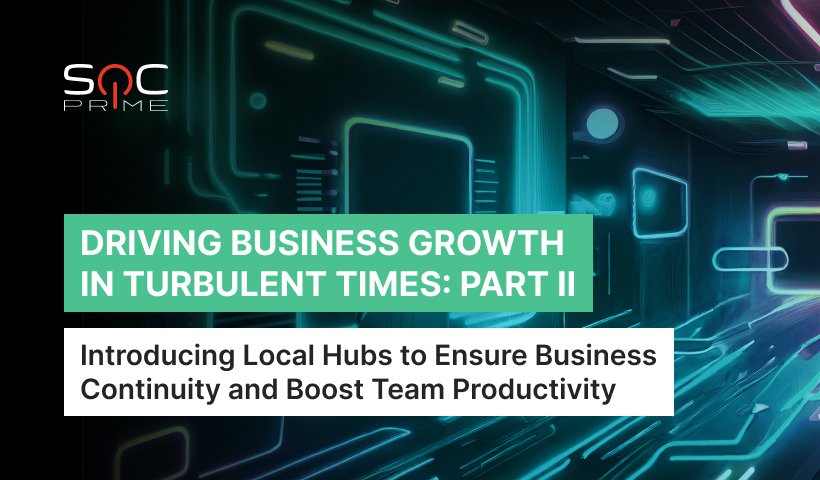Driving Business Growth in Turbulent Times from CISO’s Perspective: Part II

Dive Into our Hubs Initiative as an Alternative to Remote Work Strategy: What’s Behind the Concept and How it Boosts Team Productivity
In this second part of the interview with SOC Prime’s CISO, Vlad Garaschenko, we’ll share insights into our progressive “hubs” initiative ensuring safety and productivity of the SOC Prime team.This article highlights how a remote-first work culture morphed into a hub-centralized model to help SOC Prime accelerate team productivity and boost a sense of community while navigating the company through the challenges of war. To explore more about SOC Prime’s BCP, please refer to Part I of this interview.
- What are hubs and who is behind this idea?
There is no point in reinventing the wheel. We simply derived inspiration from the Israeli experience. As you know, the country has long been in a state of war, and they have pioneered the hub initiative, which enabled them to run work processes efficiently and drive business growth under constant risk of shelling or bombing. Hubs arrange people into small groups that work distributed across the country. The successful experience of this approach adopted in Israel was a solid argument for following in their footsteps.
- How do hubs actually work, and how do they help drive value?
Due to the challenging situation in Ukraine, it’s of paramount value to support each other. During wartime, keeping a finger on the pulse of what is happening with anyone on the team and their families is simpler when people are split into small groups based on their location. Today, we have one hub centered in Malaga, Spain, and another one in Poland for people who’ve decided to relocate there. As for Ukraine, since many of the team members can’t leave the country, we have multiple hubs depending on the region people are currently living in. For example, we have a central hub connecting people located in Kyiv and Kyiv region, the Lviv hub with teammates from this city and locations in its vicinity, and the Volyn hub with a new office in Lutsk provided with generators and a Starlink terminal to ensure a smooth workflow and continuous operation.
Hubs usually bring together a small number of people with disparate skills to mitigate risk. The small hubs allow us to focus on the needs of each member and solve their unique problems, like power outages or Internet connection challenges in the corresponding region. We have assigned a hub captain who is in charge of helping people located in the corresponding region solve these problems faster and more efficiently.
- How has the BCP evolved by adopting the hub approach?
The novel concept of hub-centralized work is focused on restoring the office work culture. The business continuity experience during the period of the COVID-19 pandemic enabled SOC Prime to quickly adapt to the challenges in the first months of the full-scale war since we were accustomed to working remotely from almost any location and under any circumstances. However, in the long term, remote work was not an appropriate replacement considering our unique wartime challenges, like the risks of bombing and shelling. Under the new war-related circumstances, we realize that is much more effective and cost-efficient to centralize the work processes in the company’s offices that serve as bomb shelters and are equipped with generators and Starlink terminals, so the people can find safe and stable work conditions that they are unable to provide themselves when working from home. Moreover, our teammates were seeking more social interaction after experiencing two years in a remote work from home environment.
During the war, everyone is seeking support and wants to be part of a close-knit team, therefore, returning to the office can also contribute to the psychological well-being of our people. By implementing the hubs approach, we are restoring the creative work atmosphere, which has been partly lost under remote working conditions, like animated office discussions, brainstorming, and face-to-face conversations during rest breaks. Therefore, the hubs initiative displays how business continuity has transformed from the full remote work culture to the office-centralized setting. Supplying office hubs with all the necessary equipment to ensure the people’s safety and smooth work operations enables us to have meetings with the clients no matter the circumstances and keep on delivering them high-quality services, which means the business can operate at its full capacity.
- What are other potential risks tackled in the Business Continuity Plan?
With the growing risks of the potential nuclear explosion due to the aggressor’s activity, SOC Prime has also covered this part in its current BCP. We’ve conducted a series of informational meetings to increase people’s awareness of how to act in the related circumstances, tested the system of alarm notifications, and supplied our teammates with all the necessities and medications to protect them from radiation. We live in turbulent times, and we have faced a number of challenges during the last three years, therefore, considering and rapidly addressing all potential risks that can negatively impact the people’s well-being and hinder business processes is a top priority of the BCP development team.
